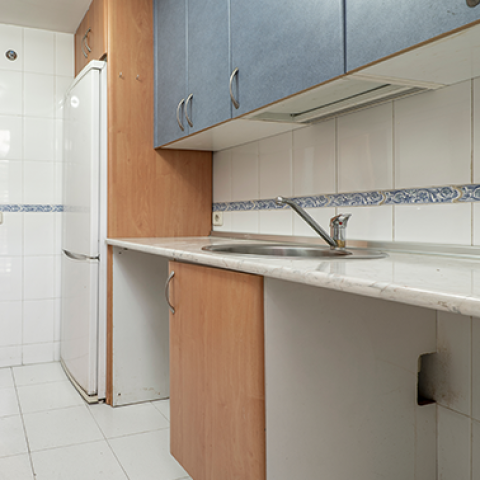Making Home More Accessible for Those Living with Multiple Sclerosis
03/10/2023
Multiple sclerosis (MS) is common – much more than previously thought. A study from 2017 found that around 1 million people in the United States alone have MS. This number is more than double the findings from decades prior.1 This means that roughly 1 in 330 people in the US have MS.2
For the many who live with the mobility and fatigue challenges brought on by MS, home modifications are essential to ease daily function. These alterations can range from basic to extensive, but here are a few recommended room by room adjustments to get started.
Kitchen
According to a recent survey, most homeowners consider the kitchen the most important room in the home.3 This room is frequently cited as one of the most used in the home as well. For those managing MS, having an accessible kitchen space in which to prepare healthy meals may be even more important. The National Multiple Sclerosis Society says that “a healthy diet can help manage MS symptoms, promote the long-term health of your nervous system and prevent other conditions.”4
When configuring a kitchen to make it accessible, fatigue management and maneuverability are key. Traditional kitchen counters are designed for standing. Create at least one lowered counter at a level that is usable by wheelchair, or from a seated position. Cabinetry can also be modified to be more accessible by removing doors/changing the hardware, and higher cabinets can be made more useful with special hardware that allows you to pull the shelves down to counter level.
Lighting is another important consideration, in all areas of the home, but especially the kitchen. When working with sharp knives and hot substances/surfaces, having adequate light helps prevent accidents.
Bathroom
The bathroom is one of the most important (but easy!) rooms to modify. Falls in the bathroom are common. Hard surfaces like tile floors, sinks, toilets and tubs are very unforgiving and lead to thousands of injuries every year.
Bathing and toileting present the biggest challenge in the bathroom. These daily activities are 2 of the most frequently associated with falls, but also activities people prefer to do alone. To preserve maximum safety and privacy, here are a few modifications to consider:
- Grab Bars
Available at any local hardware store and online, grab bars are an easy and inexpensive solution for people who need minimal support. They can be installed near the toilet and shower, but they MUST be properly anchored, or they can rip out of the wall.
- Toilet Lift
Getting up and down from the toilet requires more lower body strength than many realize. For people with moderate strength, a raised toilet seat or over-toilet safety rails are a good option. For people who need additional support, a power toilet lift like LiftSeat is ideal. LiftSeat units sit over the existing toilet to gently lower and raise the user on and off the toilet. Unlike other toilet aids, power toilet lifts support the user throughout the entire sit-to-stand process. LiftSeat also offers an optional bidet attachment, so even people with minimal mobility can use the toilet independently.
- Shower Bench
The ability to sit down while showering is helpful for fatigue management. There are some shower benches that fit wholly inside the shower, and others (called transfer benches) that straddle the tub to provide the added benefit of making it easier to enter/exit the shower or bath.
Bedroom
Carpeting is a common choice for bedrooms but can pose a tripping hazard when mobility is limited. Carpet can also make using a wheelchair more difficult. When carpeting/rugs are used, thinner is better. Non-slip pads are also beneficial to keep rugs from sliding around and causing falls—if they don’t add too much additional depth to the rug.
To ease getting in and out of bed, guardrails provide an easy, inexpensive solution. For more significant support and versatility, fully adjustable hospital beds are available. These beds are more expensive, but also have some useful features, including the ability to adjust the head and foot position independently and raise/lower the entire bed.
More Information and Resources
While the suggestions above are a good place to start for MS-friendly home modifications, the National Multiple Sclerosis Society offers comprehensive information related to managing MS, from diagnosis to current treatment options. This page on their site is particularly helpful for home modifications, with links to resources that can help cover some of the related costs and guide you in deciding which assistive technology is right for your situation.
Resources:
- National Multiple Sclerosis Society. (n.d.). MS Prevalence. National Multiple Sclerosis Society. Retrieved March 9, 2023, from https://www.nationalmssociety.org/About-the-Society/MS-Prevalence
- MacroTrends, LLC. (n.d.). U.S. population 1950-2023. MacroTrends. Retrieved March 9, 2023, from https://www.macrotrends.net/countries/USA/united-states/population
- Taylor, A. (2022, July 20). Nearly 42% Of People Agree That This Is The Most Important Room In A House. House Digest. Retrieved March 9, 2023, from https://www.housedigest.com/934307/nearly-42-of-people-agree-that-this-is-the-most-important-room-in-a-house/
- National Multiple Sclerosis Society. (n.d.). Diet and Nutrition. National Multiple Sclerosis Society. Retrieved March 9, 2023, from https://www.nationalmssociety.org/Living-Well-With-MS/Diet-Exercise-Healthy-Behaviors/Diet-Nutrition
This content is not intended to be a substitute for professional medical advice, diagnosis, or treatment. Always seek the advice of your physician or other qualified health provider with any questions you may have regarding a medical condition.